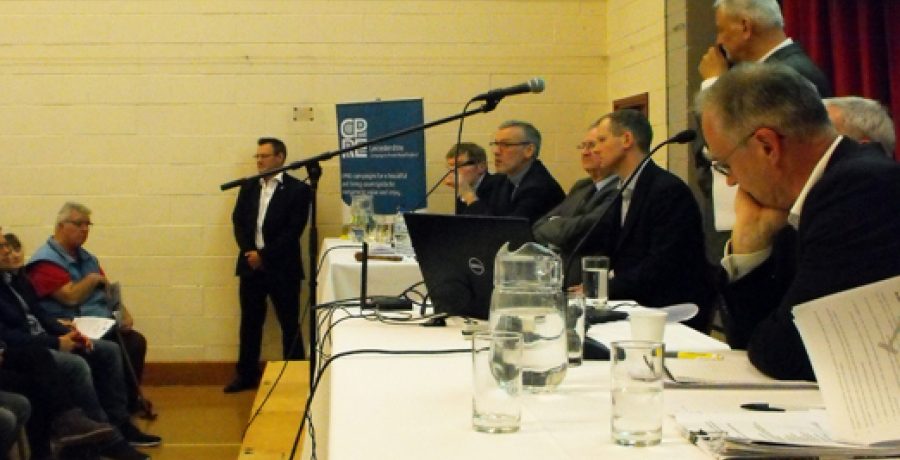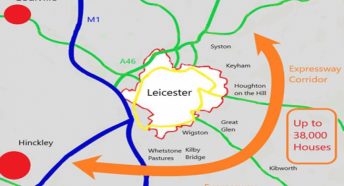A46 Expressway meeting – a great success
The plan for the A46 Expressway was heavily challenged at a very well attended meeting held at the Coplow Centre in Billesdon on Thursday 4th April.
Attended by nearly 300 people, the meeting had been organised by CPRE Leicestershire and its partner organisations, South and East Leicestershire Action Group (SELAG) and Willoughby Waterleys Residents Association (WWRA).
This meeting was about raising public awareness, mobilising concerns and updating the public about the expressway proposal and the strategy set out in the County Strategic Growth Plan (SGP) to place 38,000 new houses, logistics and other infrastructure development along its route to south and east of Leicester.
Concerned residents heard from speakers from CPRE, SELAG and WWRA as well as the local MP, Neil O’Brien, and County Councillor, Simon Galton. All were highly critical, challenging the case for the SGP and the Expressway and calling for alternative solutions to be examined.
Tony Stott, Chair of CPRE Leicestershire Task Group
Speaking on behalf of CPRE Leicestershire, Tony Stott, who chairs the branch’s SGP task group, said that very early on CPRE had recognised any city- and county-wide strategic growth would raise major concerns. So questioning and responding to the SGP and the A46 has been a major priority for CPRE Leicestershire since 2016.
In doing this, Tony said, CPRE had come to view the SGP as a ‘flawed plan’. They have substantial concerns about the housing numbers on which the plan was based, its emphasis on new road building and its neglect of SGP’s impact on the countryside, especially High Leicestershire. CPRE was also frustrated at the lack of public engagement, transparency and public scrutiny involved in way the SGP was developed and endorsed by all the Councils.
Tony briefly mentioned some of the things that CPRE and its Task Group had been doing. These included working with a consultant, Gerald Kells, since 2017; responding to consultations in 2016 and 2018; submitting evidence to the County Council Scrutiny Commission on two occasions in 2018; and organising two public meetings, one in February 2018 in Great Glen and the April 4th meeting to raise public awareness as well as press releases, interviews and letters to the press.
Other important activities have involved lobbying and meeting MPs and Councillors, as well as gathering evidence through meetings with Local Authority Officers, Midlands Connect and submitting Freedom of Information (FOI) requests.
The result of all this activity was that CPRE Leicestershire has been asking critical questions about what was being proposed, marshalling and putting forward strongly argued criticisms of what is being planned and playing a key role in raising public awareness and of the issues involved.
Tony concluded by arguing that the process was now at a crucial stage when some key decisions are being made. “We need to be objecting and mobilising now,” he said. Members of the audience should ask the candidates standing in the Local Elections on May 2nd for their views and tell them of their concerns.
Gerald Kells, CPRE’s Consultant, questions the SGP and Expressway proposals
In his talk, Gerald Kells focused on the technical issues mainly relating to housing figures and transport. In doing this, he questioned the underlying assumptions of the SGP and the case for building A46 Expressway.
He argued that the level of housing need that forms the basis of the SGP was exaggerated. The most recent independent projections from the Office of National Statistics suggest that the overall number of houses needed in Leicestershire is not nearly as high as indicated in the SGP. In particular, compared with the figures in the SGP, these forecasts suggest that Leicester only needs a little more than half the amount of new housing in the next 20 years.
Added to this, there is a problem that there is no up-to-date information on the housing land in Leicester and how much housing it can actually provide. It is also unclear that the city is maximising the use of its brownfield land. CPRE believe that Leicester can supply more housing on brownfield and windfall sites.
Turning to the A46 Transport issue, Gerald suggested that Leicester’s congestion problems were driven by traffic wanting access to and from Leicester, especially in peak times. It was not simply a problem on one route but across local roads. CPRE view this issue as a network problem that requires solutions across the whole network.
In this regard, building the Expressway would not work. The proposal relies on a ‘predict and provide’ approach by the Councils, Midlands Connect and Highways England that exaggerates future traffic growth. In addition, there is strong evidence that building new road infrastructure increases traffic.
So building a new A46 Expressway round Leicester would not solve these problems. Instead, it would facilitate additional traffic growth that would create more congestion on the routes from the east and south of Leicester. Together with housing developments along its route, it would encourage commuting into Leicester from further away, with traffic using the radial routes from the Expressway into Leicester.
In addition, it is a myth to suggest that this new route would solve the problems for through traffic going around Leicester on the A46. Less than 20% (and even less in peak times) of the traffic on the current A46 is through traffic and less than 10% of that is HGVs. The end result would be an increase in local traffic on this route and more congestion on roads into Leicester.
Along with a need for Councils to value the countryside of High Leicestershire, promote regeneration of urban areas and address climate change, a strategy to reduce traffic was required.
He concluded by indicating that CPRE was proposing a five-stage Transport Approach. This would involve:
- Getting rid of the Expressway plan
- Investing in public transport access to Leicester
- Considering Demand Management measures in Leicester
- As a stop gap, investing in specific intervention on the existing A46
- Only if needed to support the above measures, some small-scale road capacity additions
Other speakers
Philip Bland, Chair of SELAG argued that a new road through High Leicestershire would decimate a truly beautiful part of the County and urged the audience to get involved in the campaign. The Chair of WWRA, David Campbell-Kelly, explained that plans were being drawn up now for a large new Garden Village at Whetstone Pastures, which would have a massive and adverse impact upon Willoughby Waterleys. It was urgent for people to get involved in the campaign now.
Neil O’Brien, MP, and County Councillor, Simon Galton, wanted to see alternative options worked up, particularly as the City has scope to meet far more of its own housing needs and the Expressway will make transport problems worse on east and south sides of Leicester.
Overall the meeting was a great success in highlighting local concerns about the impact of the SGP and Expressway on the beautiful countryside, villages and rural communities to the east and south of Leicester. The harmful impact of these plans will be significant.
Please help CPRE Leicestershire
Producing reports and marshalling evidence is costly and time consuming. You can help us to continue questioning the plans by donating to our funds, joining CPRE or our SGP Task Group. If you are interested, please email: info@cpreleicestershire.org.uk.
Presentation: A46 Expressway – the road to ruin
Presentation: Background and challenges, CPRE perspective





